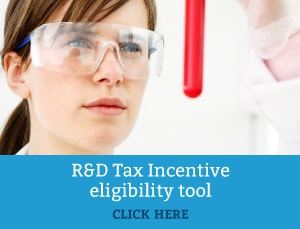R&D Tax Incentive Review
October 10th, 2016As part of the National Innovation and Science Agenda launched in December 2015, the government instigated a review of the R&D Tax Incentive programme, chaired by Mr Bill Ferris AC (Innovation Australia), DR Alan Finkel AO (Chief Scientist) and Mr John Fraser (Secretary to the Treasury).
The review sought to identify opportunities to improve the effectiveness and integrity of the programme and sought submissions from a variety of stakeholders (download the Swanson Reed submission here).
The results of the review have now been published and include a range of key recommendations. These recommendations are not yet law or changes to the R&D Tax Incentive, however the government will consider these recommendations and whether to proceed with their adoption.
Key recommendations:
- New guidance and clarity regarding eligibility of activities and expenses – Retain the current definition of eligible activities and expenses under the law, but develop new guidance, including plain English summaries, case studies and public rulings, to give greater clarity to the scope of eligible activities and expenses.
- Additional 20% non-refundable collaboration premium – Introduce a collaboration premium of up to 20 percent for the non-refundable tax offset to provide additional support for the collaborative element of R&D expenditures undertaken with publicly-funded research organisations. The premium would also apply to the cost of employing new PhD or equivalent graduates in their first three years of employment.
- $2 million cap for refundable R&D tax offsets – Introduce a cap in the order of $2 million on the annual cash refund available under the R&D Tax Incentive, with remaining offsets to be treated as a non-refundable tax offset carried forward for use against future taxable income.
- Expenditure intensity threshold for non-refundable offset – Introduce an intensity threshold in the order of 1 to 2 percent of total business expenditure for recipients of the non-refundable component of the R&D Tax Incentive. It would be proposed that only R&D expenditure in excess of the threshold attract a tax benefit.
- Increased eligible expenditure cap to $200 million – If an R&D intensity threshold is introduced, increase the expenditure cap to $200 million so that large R&D-intensive companies retain an incentive to increase R&D in Australia.
- Administration of the R&D Tax Incentive – Investigate changes to the administration of the R&D Tax Incentive for potential improvements E.g. adopting a single application process; developing a single programme database; reviewing the two-agency delivery model; and streamlining compliance review processes and resourcing.
The review panel made a series of recommendations for potential changes to the programme and the consultation process for submissions on these recommendations closed in October 2016.
The recommendations are not yet law or changes to the R&D Tax Incentive. The government are now considering the recommendations in conjunction with the submissions.
The government’s response to the review is schedule to be released in 2017.
Download the Swanson Reed submission here.
Categories
- ATO Guidance and Materials
- AusIndustry Guidance and Materials
- Case Law
- Federal Budget 2021
- Federal Budget 2022
- For Accountants
- General Information
- Government Policy and Treasury
- Industry Specific Issues
- Interpretative Decisions
- Legislation and Parliamentary Matters
- R&D Tax Credit
- R&D Tax Funding Strategies
- R&D Tax Loans
- Recent News
- Tax Determinations
Archives
- April 2024
- March 2024
- February 2024
- January 2024
- December 2023
- November 2023
- October 2023
- September 2023
- August 2023
- July 2023
- June 2023
- May 2023
- April 2023
- March 2023
- February 2023
- January 2023
- December 2022
- November 2022
- October 2022
- September 2022
- August 2022
- July 2022
- June 2022
- May 2022
- April 2022
- March 2022
- February 2022
- January 2022
- December 2021
- November 2021
- October 2021
- September 2021
- August 2021
- July 2021
- June 2021
- May 2021
- April 2021
- March 2021
- February 2021
- January 2021
- December 2020
- November 2020
- October 2020
- September 2020
- August 2020
- July 2020
- June 2020
- May 2020
- April 2020
- March 2020
- February 2020
- January 2020
- December 2019
- November 2019
- October 2019
- September 2019
- August 2019
- July 2019
- June 2019
- May 2019
- April 2019
- March 2019
- February 2019
- January 2019
- December 2018
- November 2018
- September 2018
- July 2018
- June 2018
- May 2018
- April 2018
- March 2018
- February 2018
- January 2018
- December 2017
- November 2017
- September 2017
- August 2017
- July 2017
- June 2017
- May 2017
- April 2017
- March 2017
- February 2017
- January 2017
- December 2016
- November 2016
- October 2016
- September 2016
- August 2016
- July 2016
- June 2016
- May 2016
- April 2016
- March 2016
- February 2016
- January 2016
- December 2015
- November 2015
- October 2015
- September 2015
- August 2015
- July 2015
- June 2015
- May 2015
- April 2015
- March 2015
- February 2015
- January 2015
- November 2014
- October 2014
- September 2014
- August 2014
- July 2014
- June 2014
- May 2014
- April 2014
- March 2014
- February 2014
- January 2014
- December 2013
- November 2013
- October 2013
- September 2013
- May 2013
- April 2013
- March 2013
- September 2012
- August 2012
- June 2012


 Free Call: 1300 009 390
Free Call: 1300 009 390





 News & Research
News & Research



